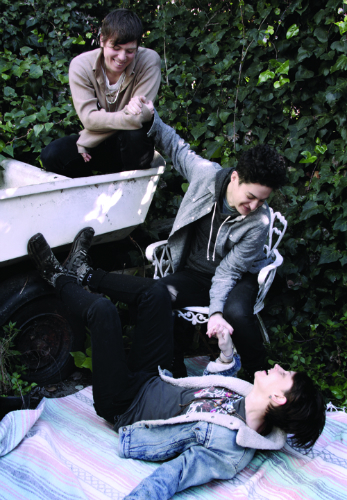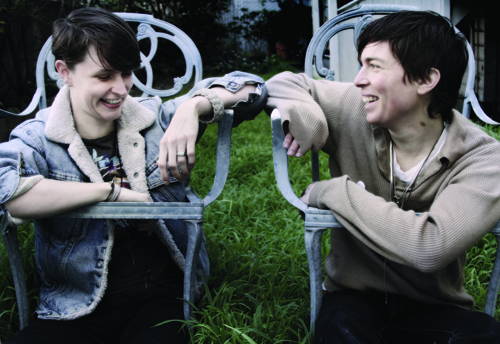
By Andy Blum
Kerby Ferris “light” percussion, keyboards, vocals
Carolyn “Cubby” Berk vocals

Photos by Hannah Cairns
Tom Tom Magazine: How would you define your sound?
Emily: electro-pop, for lack of a better term
Cubby: I think we’re feminists…. electro-pop
Kerby: it’s like, lunation eletro-pop
Cubby: it’s lunar. 3-part harmony, people on moon cycle, pop-ular music. (Laughs)
TTM: Well, you were a part of a feminist drum circle at Fabulosa Fest this past summer, right? Are Lovers spiritual?
E: I feel like these two’s spirituality is much more developed than mine. I’m sort of a new thinker of spirituality
K: I think yr new at labeling certain aspects of yr life as spiritual, but I don’t think you’re new at trying to live a righteous life (laughs)
TTM: I mean you’ve been wearing crystals for years, (laughs). Can you talk a little about Dark/Light that came out in October?
C: It’s the first album we’ve done as a trio. I feel like it was a wonderful process. It is a great document of where the band was and what we wanted to say at that time. We are still touring behind the album.
TTM: How do your songs come about?
K: It’s usually lyrical driven. Caroline will usually have a vocal with guitar prototype and then usually we sit down with Emily’s 505, the groovebox, and collaboratively work out a backbone for the song. I think that’s been really interesting for our process because with this band we’ve all been very flexible about doing things we’ve never done and so at the beginning when we were trying to write songs on instruments we’d barely even used before it was harder to get something that would work at all. It would take a long time, but when we got the groove box it felt like ideas were translating into songs in this really fluid way and I think that really helped our songwriting process.
TTM: What is a groovebox?
E: Roland makes a series of grooveboxes. They have a 303, 505, 808 and a 909. It’s sort of like a music production center, so there are many drum sounds and melodic sounds and bass and synth and all those things. So you just lay down all the drum tracks you want, all the bass lines, all the melodies, overtones, and you create the back bone of the song in this piece of equipment which then I play drums along too, Kerby plays percussion and her keyboard parts…
K: We embellish from there.
TTM: can you talk about the evolution of the percussion in the band because I remember a couple years ago Emily was playing guitar and you (Kerby) were playing this contraption you had made out of PVC pipe with a floor tom and now you have a whole different set up with a keyboard.
K: When we started playing together Caroline had written another album that she was wanting to support and do some tour for and we hadn’t been involved in the production or writing process of that. We started playing together and working on those songs and I was doing a sort of hybrid electronic and acoustic percussion to go along with those tracks. We’ve been through all these iterations.
E: But, also, this thing happened where we got this gig at the University of Oregon that Kerby had a conflict and couldn’t make the show and all of a sudden we didn’t have our melodic guy.
K: My sister was turning 21 and needed to go to Las Vegas (laughs).
E: So then we decided we can handle this, that’s when we got out the groovebox out and I was like “we’ll just make all those sounds in the groovebox”. So Cubby and I sat down and we re-did all these songs that we had been working on into the groovebox. And that’s when it finally clicked and that’s when Kerby started playing keyboards and her percussion over it and I started playing drums along to it. And Cubby wanted to sing and not play guitar.
K: It was like before that groovebox we were all doing these things we didn’t want to do and everything was so hard and then it was one of those moments where everything was just (makes noise)…
C: We had a BANG moment!
K: Yeah, we totally did!
TTM: Cubby do you have any favorite songs on Dark/Light?
C: Right now it’s the song “Shepard of the Stray Hearts”. It has certain themes in it I am still interested in and interested in developing more.
TTM: Can you talk about “>“Figure 8”?
C: It’s a torch song – it’s meant to be an empowering song for all people. Obviously, for me, it has a lot to do with being gay and just remembering we’re powerful, and our progress and our work and our love is magical. The world just needed a song like that, just to make sure that was out there, that I had said that.
TTM: Kerby, you lived in Brazil for five years, can you speak on how the music scenes differ?
K: In many, many ways. It’s just a part of the world in a different situation. Getting an instrument and getting a place to practice it and getting people together is a huge feat there, in a way that is really easy in Portland. I did play music there and it was such a struggle to do things that are so easy to take for granted here. So, that is really different. People that make independent music there are so passionate about what they do, they climb these mountains to make it happen and I think that creates an energy that is really beautiful and inspiring. But it’s interesting, because the places are so different, especially Portland and San Paulo, because the inspirations in the groups of musicians I ran with in those two spots were so similar. People had really caught on to the same magical moments, being around feminist music and queercore like Team Dresch and Sleater-Kinney, all these bands had really touched people there in a way I thought was really interesting and exciting.
TTM: Emily, did you start playing guitar or drums?
E: My first rock instrument was the drums, and then when I started playing music with STS she played drums and so I was like “I should figure out this guitar thing” cause I did play some guitar. I don’t fancy myself a good guitar player but doing fast power chords is not that hard. I started playing guitar more seriously because I wanted to be in this project with STS, which was the Haggard.
TTM: What’s your favorite part about playing drums?
E: The how active it is, how infectious it sounds.
TTM: Lastly I wanted to ask if anything influences your technique?
E: I am really inspired by Brazilian drumming. After I went to Brazil I started taking Brazilian drumming classes and I played the Caixa, which is the snare, because in samba and during Carnival the style of drum is kind of like marching band style and everyone has their own drum instrument that they play. I chose the Caixa, the snare drum, because it is all about technique R L L R R L R L R L R L R R L R. You really have to memorize it and do it really fucking fast. And the other really interesting thing about Brazilian drumming and samba is that the emphasis is on the 2nd beat. Usually in rock it’s 1 and 3, but in Brazilian drumming it’s 2 and 4, so you get this more swingy feeling. So, if I have any technique at all it comes back to my interest in that sort of music. I fell like Kerby having also experienced Brazil in her way, I feel like, that is one of the directions I want Lovers to go, playing rhymically with those sort of interesting drum beats.
K: I would say my interest is always toward what you can with with electronics to make things sound different. Since I usually play percussion and since I play almost all digital drum sounds, I like to play around with putting sounds where they wouldn’t regularly be. So, playing a snare on a bass drum for a sec and just kind of messing up the sounds that are coming out of a really traditional drum pattern to create a percussion line that you wouldn’t expect. I feel like I play really basic boom boom chick stuff, but I just like to mix up where’s the boom and where’s the chick (laughs).
TTM: What drummers have influenced you?
E: Memhet, my Turkish drum instructor that taught me how to play samba,
Debora Biana, the drummer for the Brazilian band Dominatrix, Simone N. Pace, the drummer for Blonde Redhead, Lisa Schonberg, drummer for Explode into Colors, John Bonham, of course, and Vinhão, drummer for Brazilian punk band the Dealers
K: As for past influences, my biggest teen breakthrough moment was absolutely seeing Rachel Carns in The Need. I echo Emily’s Brazilian inspirations and love what Stella Mozgawa is doing in Warpaint, as well as Mark Shirazi’s style in Nice Nice. Currently I’m very excited about Light Asylum, and a whole lot of stuff on Manimal Vinyl (especially VoicesVoices and We are The World), and I’m super excited for the new Fleet Foxes release.

